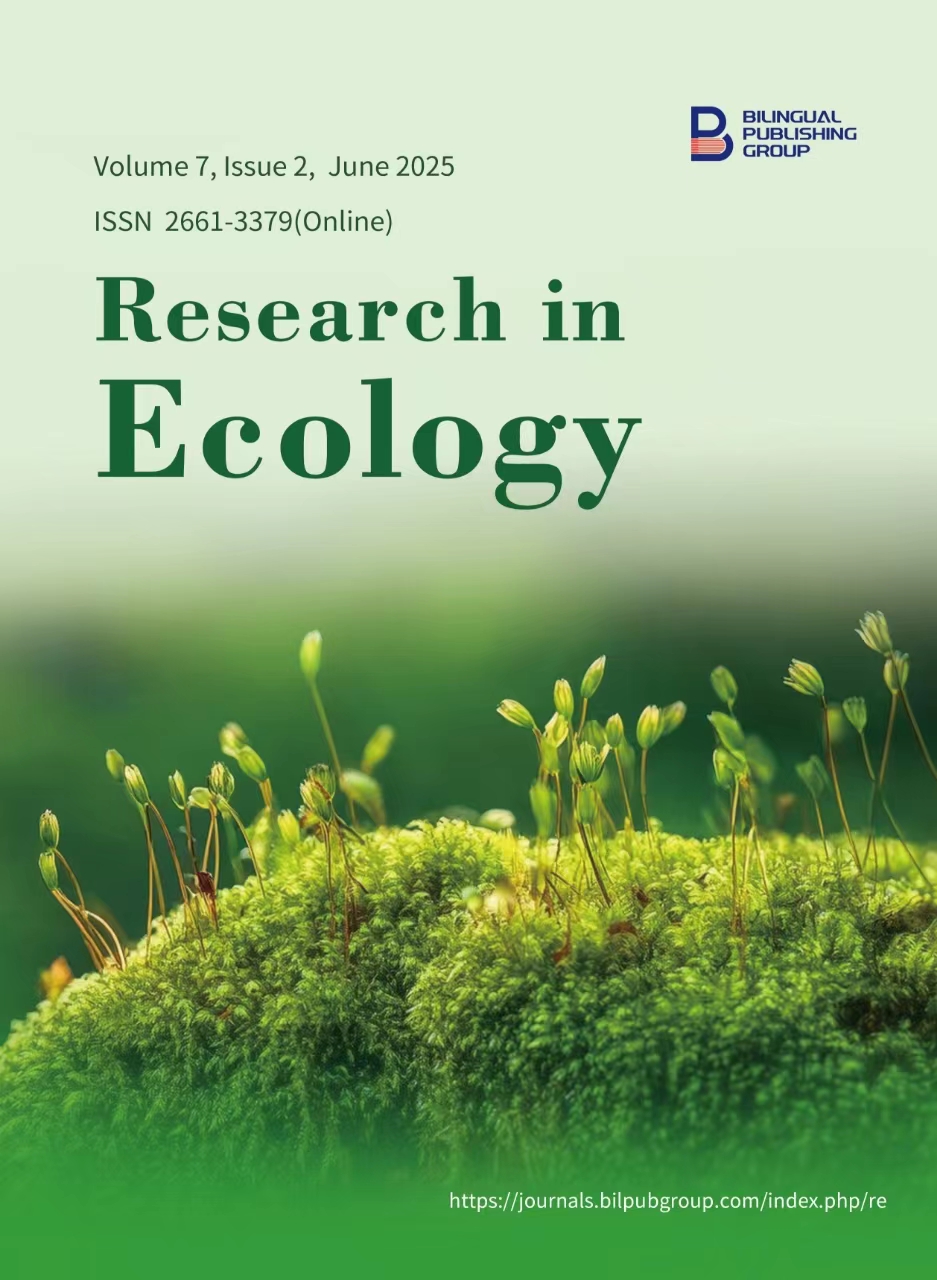
Isolation and Characterization of Plant Growth Promoting Endophytes from Linum Usitatissimum
DOI:
https://doi.org/10.30564/re.v7i2.9406Abstract
This present study identifies endophytic bacteria from Linum usitatissimum with multidimensional plant growth-promoting attributes, positioning them as ecological engineers for sustainable agriculture. Plant growth-promoting bacteria (PGPB) are present in symbiotic associations with plants or rhizosphere. These microbes enhance crop productivity and resilience under different environmental conditions. Endophytes are a type of PGPB that inhabit inside plant tissues and contribute to plant growth by phytohormone production, phosphate solubilisation, zinc solubilisation, siderophore production, ammonia production, nitrogen fixation, stress tolerance, and biocontrol mechanisms. Twelve bacterial strains were isolated from Linum usitatissimum exhibiting plant growth-promoting attributes such as ammonia and indole-3-acetic acid (IAA) production, siderophore synthesis, phosphate solubilisation, and extracellular enzyme synthesis. The isolated endophytes were also assessed for different enzymatic activities such as; cellulase, pectinase, xylanase, amylase, and gelatinase, which contribute to development of a symbiotic relationship and are crucial for the degradation of plant cell wall components The most efficient endophytes identified in the present study were Pseudomonas sp. strain JL-1 (ESL1) and Staphylococcus sciuri (ESL2), both of which displayed strong plant growth-promoting potential. ESL1 and ESL2 demonstrated promising plant growth-promoting characteristics and cellulase, pectinase, xylanase, amylase, and gelatinase, activity. ESL2 (Staphylococcus sciuri) enhanced nutrient cycling (phosphate solubilisation: 196–209 µg/ml; siderophores: 68–71%) and stress tolerance (IAA: 11–12 µg/ml), reducing reliance on synthetic inputs. By integrating flax microbiomes into agro-ecosystems, we demonstrate a scalable approach to reconcile crop productivity with soil biodiversity conservation. These results demonstrate the potentiality of these endophytic microbes in sustainable agriculture, environmental management, and microbial biotechnology. Further studies on their metabolic pathways may expand their applications in bioremediation and plant-microbe interactions.
Keywords:
Linum usitatissimum; Bacteria; Plant Growth; Biochemical; SiderophoreReferences
[1] Gupta, A., Singh, U.B., Sahu, P.K., et al., 2022. Linking soil microbial diversity to modern agriculture practices: a review. International Journal of Environmental Research and Public Health, 19(5), 3141-3169.
[2] Rafi, M.M., Krishnaveni, M.S., Charyulu, P.B.B.N., 2019. Phosphate-solubilizing microorganisms and their emerging role in sustainable agriculture. Recent developments in applied microbiology and biochemistry. 223-233.
[3] ALKahtani, M.D., Fouda, A., Attia, K.A., et al., 2020. Isolation and characterization of plant growth promoting endophytic bacteria from desert plants and their application as bioinoculants for sustainable agriculture. Agronomy. 10(9), 1325-1342.
[4] Bargaz, A., Elhaissoufi, W., Khourchi, S., et al., 2021. Benefits of phosphate solubilizing bacteria on belowground crop performance for improved crop acquisition of phosphorus. Microbiological research. 252, 126842.
[5] Ghosh, S., Bhagwat, T., Webster, T.J., 2021. Endophytic microbiomes and their plant growth-promoting attributes for plant health. Current trends in microbial biotechnology for sustainable agriculture. 245-278.
[6] Khan, K.S., Qadir, M.F., Ahmad, A., et al., 2022. Efficacy of different endophytic bacterial strains in enhancing growth, yield, and physiological and biochemical attributes of Linum usitatissimum L. Journal of Soil Science and Plant Nutrition. 22(4), 4365-4376.
[7] Afzal, I., Shinwari, Z.K., Sikandar, S., et al., 2019. Plant beneficial endophytic bacteria: Mechanisms, diversity, host range and genetic determinants. Microbiological research. 221, 36-49.
[8] Emami, S., Alikhani, H.A., Pourbabaei, A.A., et al., 2019. Effect of rhizospheric and endophytic bacteria with multiple plant growth promoting traits on wheat growth. Environmental Science and Pollution Research. 26, 19804-19813.
[9] Abdykadyrova, A.B., Aipova, R., Raisov, B.O., et al., 2020. PGPR Bacteria-Promising Objects to Create BIOFERTILIZERS of Complex Action. Eurasian Journal of Applied Biotechnology. 1, 204-215.
[10] White, J.F., Kingsley, K.I., Kowalski, K.P., et al., 2018. Disease protection and allelopathic interactions of seed-transmitted endophytic pseudomonads of invasive reed grass (Phragmites australis). Plant and Soil. 422, 195-208.
[11] White, J.F., Kingsley, K.L., Zhang, Q., et al., 2019. Endophytic microbes and their potential applications in crop management. Pest management science. 75(10), 2558-2565.
[12] Muhammad, M., Ahmad, M.W., Basit, A., et al., 2024. Plant growth-promoting rhizobacteria and their applications and role in the management of soilborne diseases. In Bacterial secondary metabolites Elsevier. 59-82.
[13] Feller, U., Anders, I., Wei, S., 2019. Distribution and redistribution of 109Cd and 65Zn in the heavy metal hyperaccumulator Solanum nigrum L.: influence of cadmium and zinc concentrations in the root medium. Plants. 8(9), 340-356.
[14] Imran, M., Sun, X., Hussain, S., et al., 2019. Molybdenum-induced effects on nitrogen metabolism enzymes and elemental profile of winter wheat (Triticum aestivum L.) under different nitrogen sources. International journal of molecular sciences. 20(12), 3009-3025.
[15] Saleem, M.H., Ali, S., Hussain, S., et al., 2020. Flax (Linum usitatissimum L.): A potential candidate for phytoremediation? Biological and economical points of view. Plants. 9(4): 496-511.
[16] Wojtasik, W., Dymińska, L., Hanuza, J., et al., 2024. Endophytic non-pathogenic Fusarium oxysporum reorganizes the cell wall in flax seedlings. Frontiers in Plant Science. 15, 1352105.
[17] Jamili, S., Zalaghi, R., Mehdi Khanlou, K., 2024. Changes in microRNAs expression of flax (Linum usitatissimum L.) planted in a cadmium-contaminated soil following the inoculation with root symbiotic fungi. International Journal of Phytoremediation. 26(8), 1221-1230.
[18] Omer, A.M., Osman, M.S., Badawy, A.A., 2022. Inoculation with Azospirillum brasilense and/or Pseudomonas geniculata reinforces flax (Linum usitatissimum) growth by improving physiological activities under saline soil conditions. Botanical Studies. 63(1), 15.
[19] Bergey, D.H., 1994. Bergey's manual of determinative bacteriology. Lippincott Williams & Wilkins. Philadelphia, USA
[20] Gordon, S.A., Weber, R.P., 1951. Colorimetric estimation of indoleacetic acid. Plant physiology. 26(1), 192.
[21] Schwyn, B., Neilands, J., 1987. Universal chemical assay for the detection and determination of siderophores. Analytical biochemistry. 160(1), 47-56.
[22] Alexander, D.B., Zuberer, D.A., 1991. Use of chrome azurol S reagents to evaluate siderophore production by rhizosphere bacteria. Biology and Fertility of soils. 12, 39-45.
[23] Marques, A.P., Pires, C., Moreira, H., et al., 2010. Assessment of the plant growth promotion abilities of six bacterial isolates using Zea mays as indicator plant. Soil Biology and Biochemistry. 42(8), 1229-1235.
[24] Kazanas, N., 1968. Proteolytic activity of microorganisms isolated from freshwater fish. Applied microbiology. 16(1), 128-132.
[25] Teather, R.M., Wood, P.J., 1982. Use of Congo red-polysaccharide interactions in enumeration and characterization of cellulolytic bacteria from the bovine rumen. Applied and environmental microbiology. 43(4),777-780.
[26] Zainab, N., Din, B.U., Javed, M.T., et al., 2020. Deciphering metal toxicity responses of flax (Linum usitatissimum L.) with exopolysaccharide and ACC-deaminase producing bacteria in industrially contaminated soils. Plant physiology and biochemistry. 152, 90-99.
[27] Bhandari, G., Gangola, S., Bhatt, P., et al., 2024. Potential of the plant rhizomicrobiome for bioremediation of contaminants in agroecosystems. Frontiers in Plant Science. 15, 1397360.
[28] Gangola, S., Joshi, S., Bhandari, G., et al., 2023. Exploring microbial diversity responses in agricultural fields: a comparative analysis under pesticide stress and non-stress conditions. Frontiers in Microbiology. 14, 1271129.
[29] Gangola, S., Bhandari, G., Joshi, S., et al., 2023. Esterase and ALDH dehydrogenase-based pesticide degradation by Bacillus brevis 1B from a contaminated environment. Environmental Research. 232, 116332.
[30] Bhatt, P., Gangola, S., Ramola, S., et al., 2023. Insights into the toxicity and biodegradation of fipronil in contaminated environment. Microbiological research. 266, 127247.
[31] Bhutani, N., Maheshwari, R., Kumar, P., et al., 2021. Bioprospecting for extracellular enzymes from endophytic bacteria isolated from Vigna radiata and Cajanus cajan. J Appl Biol Biotechnol. 9(3), 26-34.
[32] Kumar, V., Rajauria, G., Sahai, V., et al., 2012. Culture filtrate of root endophytic fungus Piriformospora indica promotes the growth and lignan production of Linum album hairy root cultures. Process Biochemistry. 47(6), 901-907.
[33] Gangola, S., Joshi, S., Kumar, S., et al., 2021. Differential proteomic analysis under pesticides stress and normal conditions in Bacillus cereus 2D. PLoS One. 16(8), e0253106.
[34] Bhatt, P., Bhandari, G., Bhatt, K., et al., 2021. Plasmid-mediated catabolism for the removal of xenobiotics from the environment. Journal of Hazardous Materials. 420, 126618.
[35] Gangola, S., Sharma, A., Bhatt, P., et al., 2018. Presence of esterase and laccase in Bacillus subtilis facilitates biodegradation and detoxification of cypermethrin. Scientific reports. 8(1),12755.
[36] Eid, A.M., Salim, S.S., Hassan, S.E.D., et al., 2019. Role of endophytes in plant health and abiotic stress management. Microbiome in plant health and disease: challenges and opportunities. 119-144.
[37] Sopalun, K., Iamtham, S., 2020. Isolation and screening of extracellular enzymatic activity of endophytic fungi isolated from Thai orchids. South African Journal of Botany. 134, 273-279.
[38] Admassie, M., Woldehawariat, Y., Alemu, T., 2022. In vitro evaluation of extracellular enzyme activity and its biocontrol efficacy of bacterial isolates from pepper plants for the management of Phytophthora capsici. BioMed research international. 2022(1), 6778352.
[39] Gangola, S., Joshi, S., Bhandari, G., et al., 2023. Omics approaches to pesticide biodegradation for sustainable environment. In Advanced Microbial Techniques in Agriculture, Environment, and Health Management Academic Press. Cambridge, Massachusetts, USA. (pp. 191-203).
[40] Bhandari, G., Chaudhary, S., Chaudhary, P., et al., 2025. Plant–microbes–nanofertilizers and their interactions for plant growth promotion and stress management. In Nano-bioinoculants Academic Press. Cambridge, Massachusetts, USA. (pp. 173-191).
[41] Gangola, S., Joshi, S., Joshi, D., et al., 2022. Advanced Molecular Technologies for Environmental Restoration and Sustainability. Bioremediation of Environmental Pollutants: Emerging Trends and Strategies. 385-396.
[42] Bhandari, G., Sharma, M., Negi, S., et al., 2022. System biology analysis of endosulfan biodegradation in bacteria and its effect in other living systems: modeling and simulation studies. Journal of Biomolecular Structure and Dynamics. 40(23), 13171-13183.
[43] Al-Amri, S.M., 2021. Application of bio-fertilizers for enhancing growth and yield of common bean plants grown under water stress conditions. Saudi Journal of Biological Sciences. 28(7), 3901-3908.
[44] Bahrami Abdehgah, I., Khodavandi, A., Shamsazar, A., et al., 2017. In vitro antifungal effects of biosynthesized silver nanoparticle by Candida albicans against Candida glabrata. Biomedical Research. 28(7):2870-2886.
[45] Naveed, M., Mitter, B., Yousaf, S., et al., 2014. The endophyte Enterobacter sp. FD17: a maize growth enhancer selected based on rigorous testing of plant beneficial traits and colonization characteristics. Biology and fertility of soils. 50, 249-262.
Downloads
How to Cite
Issue
Article Type
License
Copyright © 2025 Shalu Choudhary, Geeta Bhandari, Anant Deogaonkar, Deepshree Kumar, Kanishka Miglani, Sanjay Gupta, Samiksha Joshi, Amit Mittal, Saurabh Gangola

This is an open access article under the Creative Commons Attribution-NonCommercial 4.0 International (CC BY-NC 4.0) License.




 Shalu Choudhary
Shalu Choudhary






